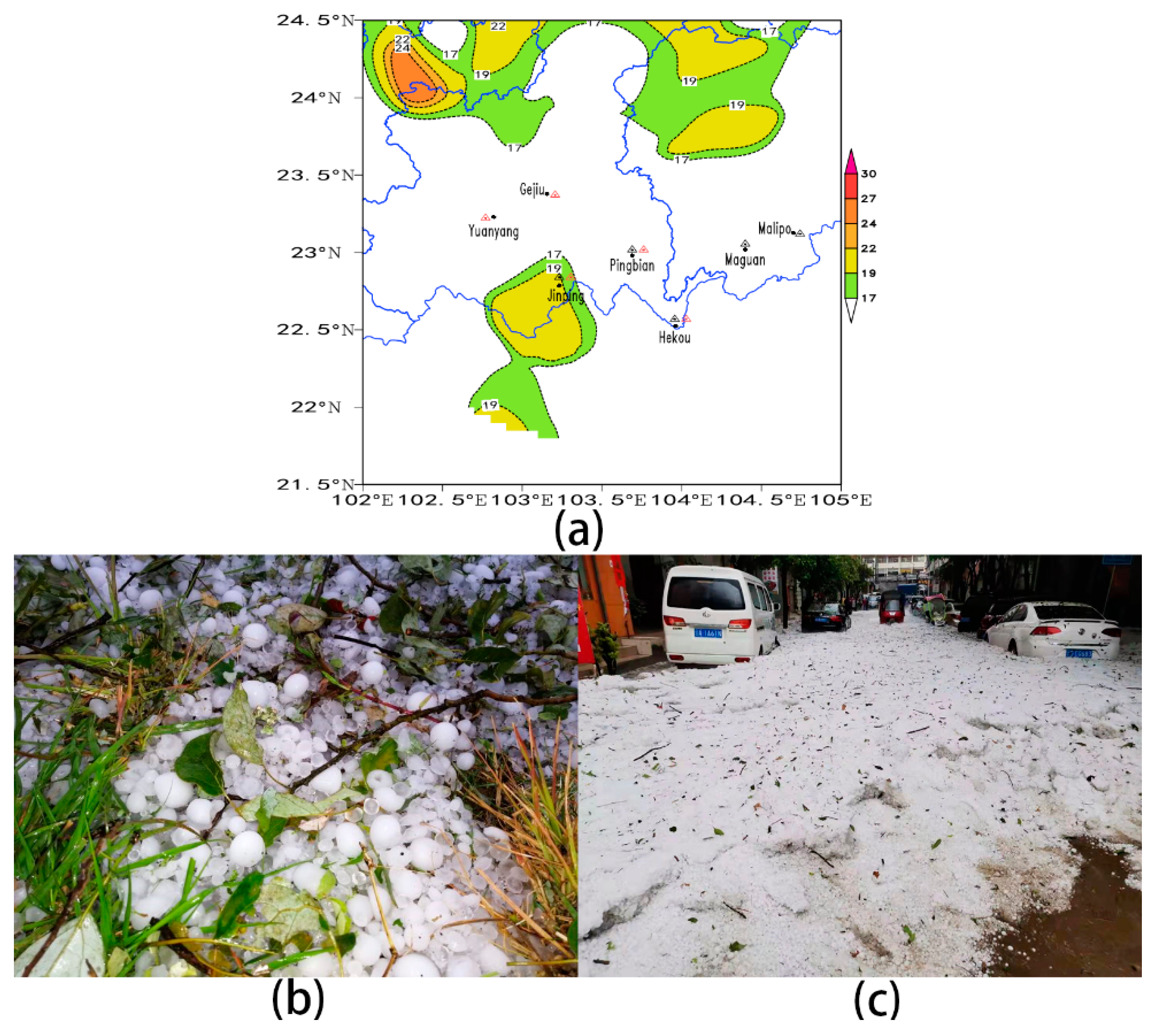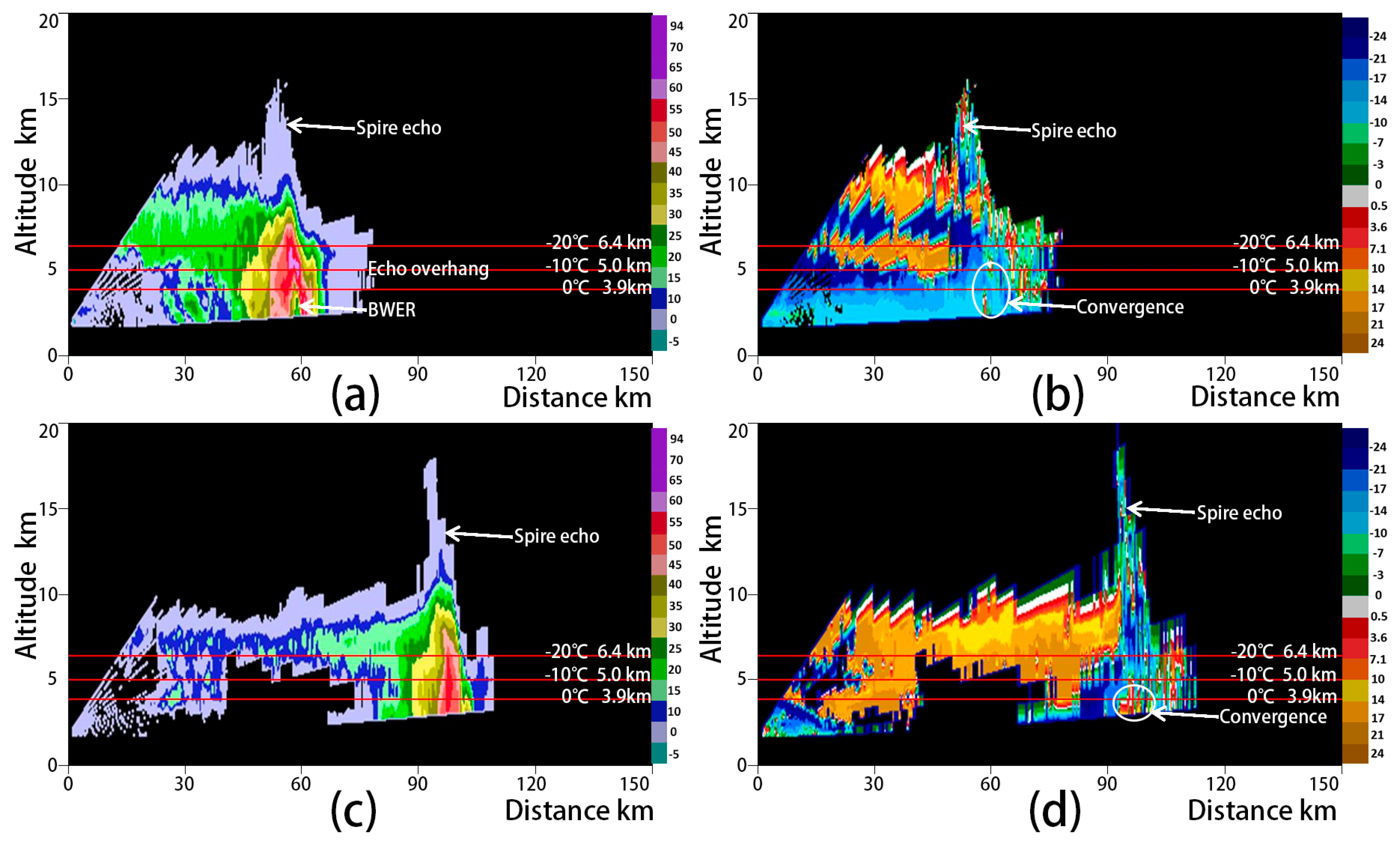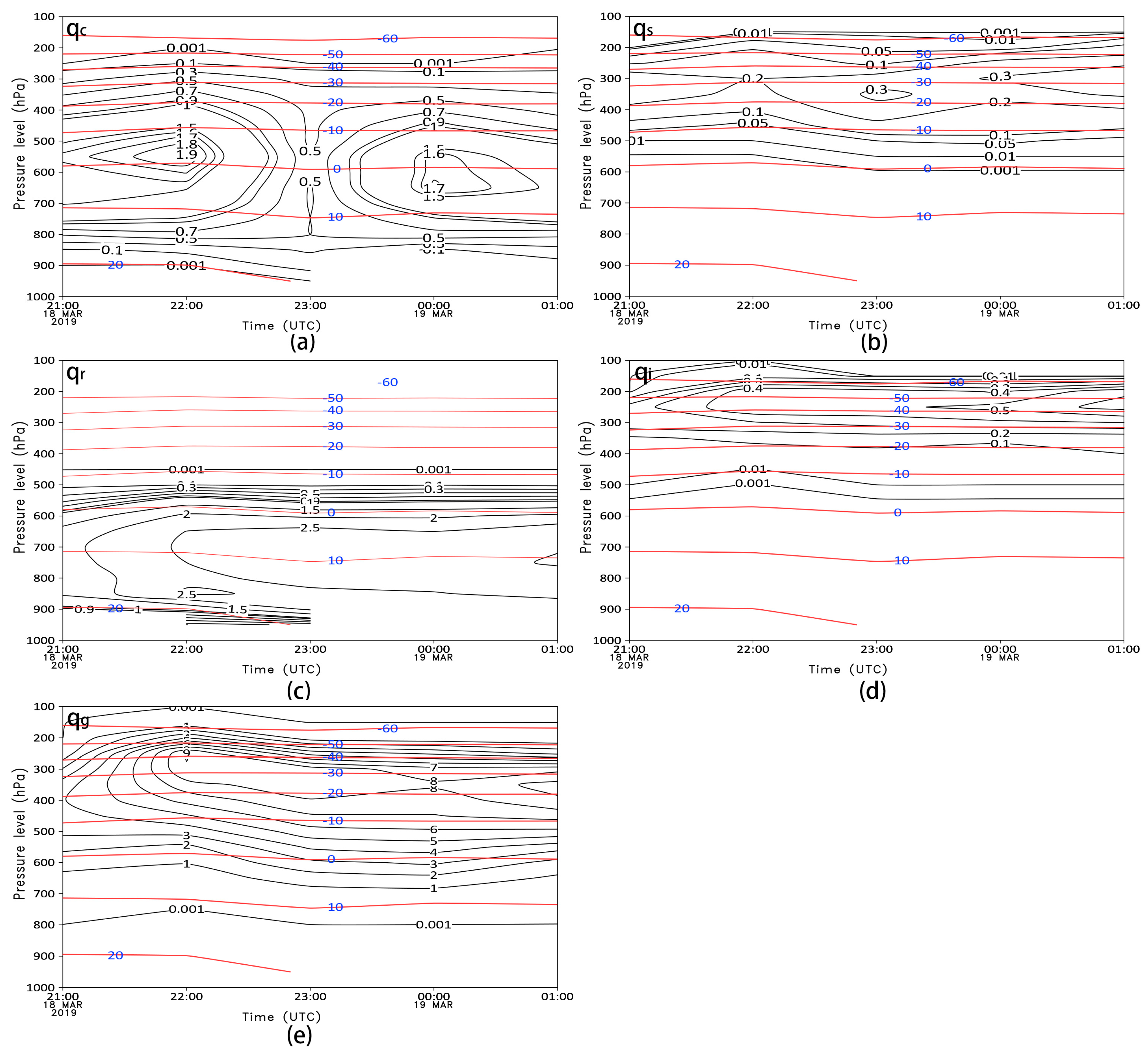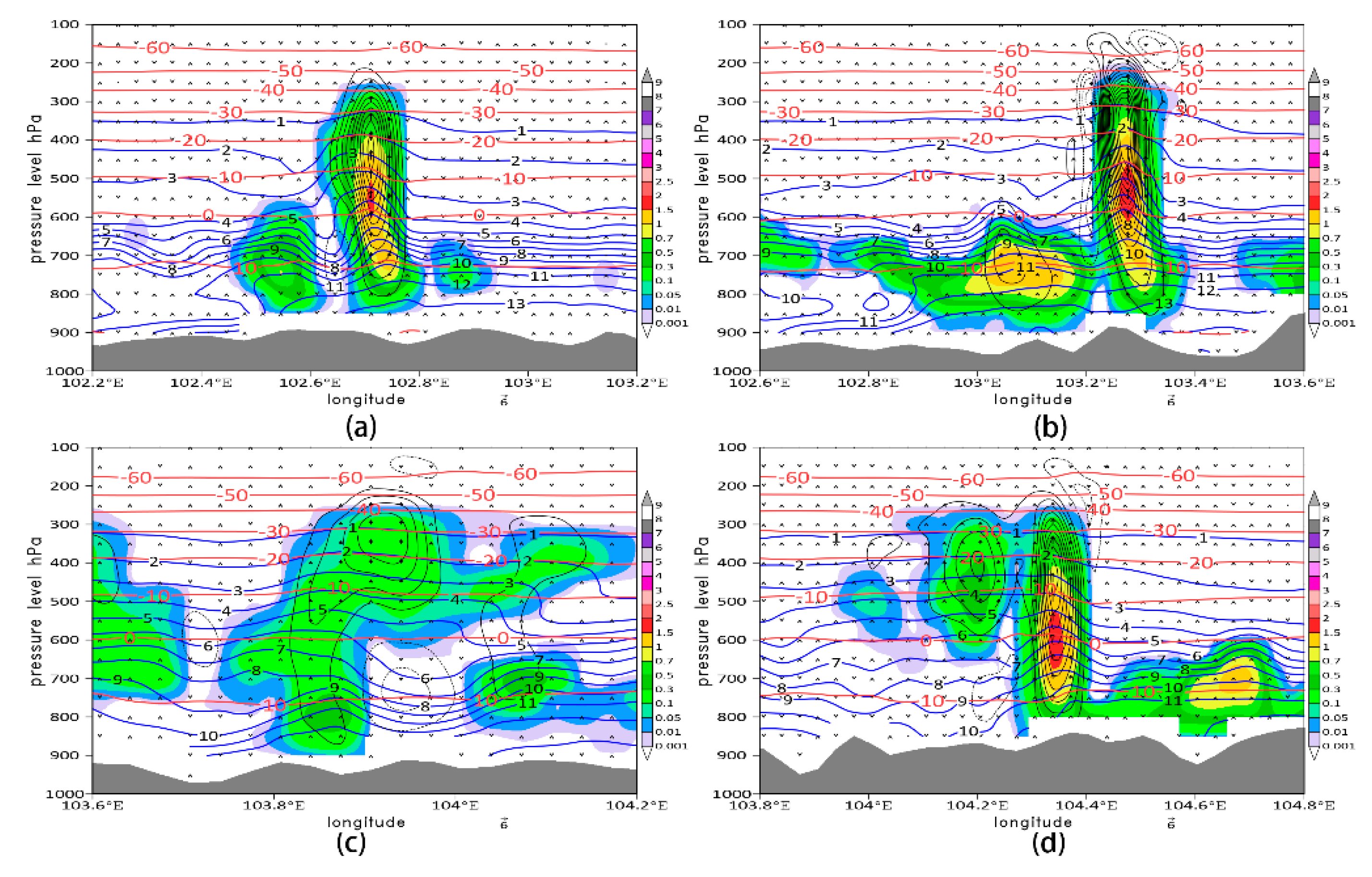Analysis on the Evolution and Microphysical Characteristics of Two Consecutive Hailstorms in Spring in Yunnan, China
Abstract
1. Introduction
2. Data and Simulation Methods
2.1. Data
2.2. Simulation Methods
3. Hail Process Characteristics
3.1. Synoptic Characteristics
3.2. Synoptic Background
3.3. Radar Echo Characteristics
3.3.1. Plan Position Indicator (PPI) Characteristics
- (a)
- The First Hail Process
- (b)
- The Second Hail Process
3.3.2. Range Height Indicator (RHI) Characteristics
4. Simulation Results
4.1. Hail Cloud Physical Structure Characteristics
4.1.1. Horizontal Structure
- (a)
- The First Hail System
- (b)
- The second hail system
4.1.2. Vertical Structure
- (a)
- The first Hail System
- (b)
- The Second Hail System
4.2. Distribution Characteristics of Various Hydrometeors
5. Discussion
6. Conclusions
- (a)
- The southwesterly airflow in the lower-level 700 hPa continuously delivers water vapor and energy conditions for the hailing process. Also, the intense vertical wind shear and the right anticyclonic shear divergence generated by the southwest jet in the upper-level 500 hPa provides dynamic conditions. In the common influence area of two southwest jets in front of the SBT and the periphery of WPSH, namely the right side (south side) of the southwest jet axis of the upper-level 500 hPa, the northeast-southwest banded echoes successively generated and developed twice.
- (b)
- Banded echoes move from west to east and affect southeastern Yunnan. On the east and south side, due to the convergence of local mesoscale radial wind or uneven distribution of wind speed, the warm and humid air on the lower-level front side converges into the cloud and strengthens updraft to result in the intense development of convective echo and the occurrence of hail.
- (c)
- The model can simulate the mesoscale convergence lines formed by the confluence of upper airflow, leading to the formation and development of convective cloud bands. Meanwhile, the convergence of lower-level wind direction or wind speed and upper-level divergence are conducive to the lower-level warm and humid air convergence into the cloud, and the formation of the deep tilted updraft, with the updraft up to 12~15 m·s−1 at the −40~−10 °C layer, leading to the intense development of local convective clouds.
- (d)
- The formation of hail embryos is closely related to the content of cloud water and snow crystals but has little to do with that of rainwater and ice crystals. The rich and deep cloud water droplets converge and uplift along the deep updraft. The hail embryos firstly grow through the collision-freezing with the supercooled cloud water droplets in the middle-low level, and further increase through the accretion with the snow crystals in the middle-upper level.
Author Contributions
Funding
Conflicts of Interest
References
- Zhang, C.; Zhang, Q.; Wang, Y. Climatology of Hail in China: 1961–2005. J. Appl. Meteorol. Clim. 2008, 47, 795–804. [Google Scholar] [CrossRef]
- Burcea, S.; Cică, R.; Bojariu, R. Hail Climatology and Trends in Romania: 1961–2014. Mon. Weather Rev. 2016, 144, 4289–4299. [Google Scholar] [CrossRef]
- Kahraman, A.; Tilev-Tanriover, Ş.; Kadioglu, M.; Schultz, D.M.; Markowski, P.M. Severe Hail Climatology of Turkey. Mon. Weather Rev. 2016, 144, 337–346. [Google Scholar] [CrossRef]
- Xie, B.; Zhang, Q.; Wang, Y. Trends in hail in China during 1960–2005. Geophys. Res. Lett. 2008, 35, 13801. [Google Scholar] [CrossRef]
- Huang, Y.; Wang, X.; Pei, J.; Ma, Y. Mesoscale characteristics of a rare severe hailstorm event. Theor. Appl. Clim. 2019, 132, 159–170. [Google Scholar] [CrossRef]
- Amburn, S.A.; Wolf, P.L. VIL Density as a Hail Indicator. Weather Forecast. 1997, 12, 473–478. [Google Scholar] [CrossRef]
- Bauer-Messmer, B.; Waldvogel, A. Satellite data based detection and prediction of hail. Atmos. Res. 1997, 43, 217–231. [Google Scholar] [CrossRef]
- Reynolds, D.W. Observations of Damaging Hailstorms from Geosynchronous Satellite Digital Data. Mon. Weather Rev. 1980, 108, 337–348. [Google Scholar] [CrossRef]
- Foote, G.B.; Frank, H.W. Case Study of a Hailstorm in Colorado. Part III: Airflow from Triple-Doppler Measurements. J. Atmos. Sci. 1983, 40, 686–707. [Google Scholar] [CrossRef]
- Guo, X.; Guo, X.L.; Chen, B.J.; He, H.; Ma, X.C.; Tian, P.; Zhang, X. Numerical Simulation on the Formation of Large-size Hailstones. J. Appl. Meteorol. Sci. 2019, 30, 651–664. [Google Scholar]
- Hopper, J.L.J.; Schumacher, C.; Humes, K.; Funk, A. Drop-Size Distribution Variations Associated with Different Storm Types in Southeast Texas. Atmosphere 2019, 11, 8. [Google Scholar] [CrossRef]
- Thurai, M.; Steger, S.; Teschl, F.; Schönhuber, M. Analysis of Raindrop Shapes and Scattering Calculations: The Outer Rain Bands of Tropical Depression Nate. Atmosphere 2020, 11, 114. [Google Scholar] [CrossRef]
- Hong, Y.C. A 3-D Hail Cloud Numerical Seeding Model. Acta Meteor Sin. 1998, 56, 641–653. [Google Scholar]
- Fovell, R.G.; Tan, P. The Temporal Behavior of Numerically Simulated Multicell-Type Storms. Part II: The Convective Cell Life Cycle and Cell Regeneration. Mon. Weather Rev. 1998, 126, 551–577. [Google Scholar] [CrossRef]
- Buckley, B.W.; Wang, Y.; Leslie, L.M. The Sydney Hailstorm of April 14, 1999: Synoptic description and numerical simulation. Meteorol. Atmos. Phys. 2001, 76, 167–182. [Google Scholar] [CrossRef]
- Blair, A.; Metropolis, N.; Von Neumann, J.; Taub, A.H.; Tsingou, M. A Study of a Numerical Solution to a Two-Dimensional Hydrodynamical Problem. Math. Tables Aids Comput. 2006, 13, 145. [Google Scholar] [CrossRef]
- Wang, X.M.; Zhong, Q.; Han, S.Y. A Numerical Case Study on the Evolution of Hail Cloud and the Three-Dimensional Structure of Supercell. Plateau Meteor. 2009, 28, 352–365. [Google Scholar]
- Hong, Y.C.; Xiao, H.; Li, H.Y.; Hu, Z.X. Studies on Microphysical Processes in Hail Cloud. Chin. J. Atmos. Sci. 2002, 26, 421–432. (In Chinese) [Google Scholar]
- Guo, X.L.; Huang, M.Y.; Hong, Y.C.; Xiao, H.; Zhou, L. A Study of Three-Dimensional Hail-Category Hailstorm Model Part I: Model Description and the Mechanism of Hail Recirculation Growth. Chin. J. Atmos. Sci. 2001, 25, 707–720. (In Chinese) [Google Scholar]
- Guo, X.L.; Huang, M.Y.; Hong, Y.C.; Xiao, H.; Zhou, L. A Study of Three-Dimensional Hail-Category Hailstorm Model Part Ⅱ: Characteristics of Hail-Category Size Distribution. Chin. J. Atmos. Sci. 2001, 25, 856–864. (In Chinese) [Google Scholar]
- Weisman, M.L.; Skamarock, W.C.; Klemp, J.B. The Resolution Dependence of Explicitly Modeled Convective Systems. Mon. Weather Rev. 1997, 125, 527–548. [Google Scholar] [CrossRef]
- Kain, J.S. The Kain–Fritsch convective parameterization: An update. J. Appl. Meteor. 2004, 43, 170–181. [Google Scholar] [CrossRef]
- Skamarock, W.C.; Klemp, J.B.; Dudhia, J.; Gill, D.O.; Barker, D.M.; Duda, M.G.; Huang, X.; Wang, W.; Powers, J.G. A Description of the Advanced Research WRF Version 3; NCAR Tech. Note NCAR/TN-475+STR; National Center for Atmospheric Research: Boulder, CO, USA, 2008; p. 113. [Google Scholar]
- Adams-Selin, R.D.; Ziegler, C.L. Forecasting Hail Using a One-Dimensional Hail Growth Model within WRF. Mon. Weather Rev. 2016, 144, 4919–4939. [Google Scholar] [CrossRef]
- Kang, F.Q.; Zhang, Q.; Qu, Y.X.; Ji, L.Z.; Guo, X.L. Simulating Study on Hail Microphysical Process on the Northeastern Side of Qinghai-Xizang Plateau and Its Neighborhood. Plateau Meteor. 2004, 23, 735–742. [Google Scholar]
- Fu, Y.; Liu, X.L.; Ding, W. A Numerical Simulation Study of a Severe Hail Event and Physical Structure of Hail Cloud. J. Trop. Meteorol. 2016, 32, 546–557. [Google Scholar]
- Zhang, X.J.; Tao, Y.; Liu, G.Q.; Peng, Y.X. Study on the Evolution of Hailstorm and Its Cloud Physical Characteristics. Meteorol. Mon. 2019, 45, 415–425. [Google Scholar]
- Zhang, T.F.; Duan, X.; Lu, Y.B.; Hai, Y.S. Circulation background for a severe convective hailstorm weather process in Yunnan and its Doppler radar echo features. Plateau Meteor. 2006, 25, 531–538. [Google Scholar]
- Tao, Y.; Duan, X.; Duan, C.C.; Duan, W. Change Characteristic of Yunnan Hail. Plateau Meteor. 2011, 30, 1108–1118. [Google Scholar]
- Zhang, T.F.; Zhang, J.; Zhang, S.D.; Zhu, L. Mesoscale Characteristics and Environmental Conditions of South Trough Squall-Line Hailstorm in Yunnan. Plateau Meteor. 2018, 37, 958–969. [Google Scholar]
- Lou, X.F. Development and Implementation of a New Explicit Microphysical Scheme and Comparisons of Original Schemes of MM5. Ph.D. Thesis, Peking University, Beijing, China, 2002; 140p. (In Chinese). [Google Scholar]
- Lou, X.F.; Hu, Z.J.; Wang, P.Y.; Zhou, X.J. Introduction to Microphysical Schemes of Mesoscale Atmospheric Models and Cloud Models. J. Appl. Meteorol. Sci. 2003, 14, 50–59. [Google Scholar]
- Hu, Z.J.; Yan, C.F. Numerical Simulation of Microphysical Processes in Stratiform Clouds (I)—Microphysical Model. J. Acad. Meteorol. Sci. 1986, 1, 37–52. [Google Scholar]
- Hu, Z.J.; He, G.F. Numerical Simulation of Microphysical Processes in Cumulonimbus—PART I: Microphysical Model. Acta Meteorol. Sin. 1987, 45, 467–484. [Google Scholar]
- Gao, W.H.; Zhao, F.S.; Hu, Z.J.; Zhou, Q. Improved CAMS Cloud Microphysics Scheme and Numerical Experient Coupled with WRF. Chin. J. Geophys. 2012, 55, 396–405. (In Chinese) [Google Scholar]
- Hong, S.-Y.; Noh, Y.; Dudhia, J. A New Vertical Diffusion Package with an Explicit Treatment of Entrainment Processes. Mon. Weather Rev. 2006, 134, 2318–2341. [Google Scholar] [CrossRef]
- Mlawer, E.J.; Taubman, S.J.; Brown, P.D.; Iacono, M.J.; Clough, S.A. Radiative transfer for inhomogeneous atmospheres: RRTM, a validated correlated-k model for the longwave. J. Geophys. Res. Space Phys. 1997, 102, 16663–16682. [Google Scholar] [CrossRef]
- Chou, M.D.; Suarez, M.J. An efficient thermal infrared radiation parameterization for use in general circulation models. NASA Tech. Memo. 1994, 10, 85. [Google Scholar]
- Chou, M.-D.; Suarez, M.J.; Ho, C.-H.; Yan, M.M.-H.; Lee, K.-T. Parameterizations for Cloud Overlapping and Shortwave Single-Scattering Properties for Use in General Circulation and Cloud Ensemble Models. J. Clim. 1998, 11, 202–214. [Google Scholar] [CrossRef]
- Hu, Z.X.; Li, H.Y.; Xiao, H.; Hong, Y.C.; Huang, M.Y.; Wu, Y.X. Numerical Simulation of Hailstorms and the Characteristics of Accumulation Zone of Supercooled Raindrops. Clim. Environ. Res. 2003, 8, 196–208. [Google Scholar]
- Hu, Z.X.; Qi, Y.B.; Guo, X.L.; Hong, Y.C. Numerical Simulation of Hail Formation Mechanism in East of the Tibetan Plateau. Clim. Environ. Res. 2007, 12, 37–48. [Google Scholar]
- Hu, Z.X.; Guo, X.L.; Li, H.Y.; Hong, Y.C. Numerical Simulation of a Hybrid-Type Hailstorm in Munich and the Mechanism of Hail Formation. Chin. J. Atmos. Sci. 2007, 31, 973–986. (In Chinese) [Google Scholar]
- Sulakvelidze, G.K.; Bibilashviti, N.S.; Lapcheva, V.F. Formation of Precipitation and modification of Hail Processes; The Israel Program for Scientific Translations (I.P.S.T Publisher): Jerusalem, Israel, 1967. [Google Scholar]












Publisher’s Note: MDPI stays neutral with regard to jurisdictional claims in published maps and institutional affiliations. |
© 2021 by the authors. Licensee MDPI, Basel, Switzerland. This article is an open access article distributed under the terms and conditions of the Creative Commons Attribution (CC BY) license (http://creativecommons.org/licenses/by/4.0/).
Share and Cite
Zhang, S.; Liu, S.; Zhang, T. Analysis on the Evolution and Microphysical Characteristics of Two Consecutive Hailstorms in Spring in Yunnan, China. Atmosphere 2021, 12, 63. https://doi.org/10.3390/atmos12010063
Zhang S, Liu S, Zhang T. Analysis on the Evolution and Microphysical Characteristics of Two Consecutive Hailstorms in Spring in Yunnan, China. Atmosphere. 2021; 12(1):63. https://doi.org/10.3390/atmos12010063
Chicago/Turabian StyleZhang, Sidou, Shiyin Liu, and Tengfei Zhang. 2021. "Analysis on the Evolution and Microphysical Characteristics of Two Consecutive Hailstorms in Spring in Yunnan, China" Atmosphere 12, no. 1: 63. https://doi.org/10.3390/atmos12010063
APA StyleZhang, S., Liu, S., & Zhang, T. (2021). Analysis on the Evolution and Microphysical Characteristics of Two Consecutive Hailstorms in Spring in Yunnan, China. Atmosphere, 12(1), 63. https://doi.org/10.3390/atmos12010063




